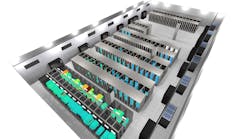Will Virtual Reality Make On-Site Data Center Tours Obsolete?
In this week’s Voices of the Industry, James Leach, Vice President of Marketing at RagingWire, looks at the impact virtual reality may have on traditional on-site data center tours.
James Leach, RagingWire Data Centers
One of the time-honored traditions of data center buying is the on-site tour. For most data center buyers, building your short list of providers can occur remotely through conference calls and reading product literature. But the final selection requires a site visit and tour.
With data centers – seeing is believing.
We see these tours all the time in Ashburn, Virginia, the largest market for data centers in the world. Ashburn is a destination market for data centers. Every day groups travel to Ashburn to tour the facilities that are the finalists for their data center deployment. Typically, these groups visit 3-5 data center providers over 2-3 days.
It is becoming more common to see “world tours” of data centers as companies deploy computing systems globally in an effort to improve systems performance and availability. Many of these tour groups are in the process of visiting Europe, Asia, and the U.S. We met with one tour group recently that was visiting 5 countries in 8 days!
Tour groups want to see the electrical, mechanical, and security systems of the data center. They walk the campus and look at the customer amenities and office space. Overall, they want to get a sense of how well the facility is run. Tours are important because a data center selection can result in a contract that lasts 5-10 years or longer.
What I’m wondering is, will virtual reality (known as VR) make these on-site data center tours obsolete?
[clickToTweet tweet=”Will virtual reality make data center tours obsolete?” quote=”Will virtual reality make data center tours obsolete?”]
The Challenge: A Remote Data Center You Need to Visit
In April 2015 we opened our CA3 Data Center in Sacramento, California. This facility draws most of it customers from the Bay Area and Silicon Valley. These customers are interested in CA3 because they get a mission-critical data center with low-cost power that is in a seismically safe area and within driving distance of their offices.
The thought process for these customers is that should an earthquake hit San Francisco, their computers will be safe in Sacramento. And when a disaster strikes, they are more likely to be able to get in a car and drive to Sacramento as opposed to getting a flight out of an airport in San Francisco, Oakland, or San Jose that is delayed or the airport is closed.
When considering a potential data center site that is not across town, its biggest benefit can also be its biggest challenge. For example, Bay Area entrepreneurs can be reluctant to drive the two hours to get to Sacramento. VR is a solution that brings the data center tour to them.
The Solution: A Virtual Reality Tour in 3D
Attendees at the Gartner data center conference in Las Vegas sampling a virtual tour of a RagingWire data center.
If you haven’t tried on a pair of virtual reality goggles and tested a sample app, you should. You will immediately be impressed with the potential of these devices and applications, and you’ll recognize that we are still in the early stages of development.
On the plus side, you will feel as if you are in another reality. The challenges can be navigating through the new reality, some discomfort from the goggles, and maybe a little motion sickness.
A well developed VR tour creates a 360-degree space in 3D, and allows you to go anywhere you want. Unlike traditional virtual tours that use animation and computer renderings, or 360-degree videos made with static individual scenes, today’s VR tour offers the depth and space of the actual data center and gives users complete control over their exploration of the environment. To move through the space you just look at where you want to go and the system automatically takes you there.
A good VR tour will also offer a menu in the app that lets you go directly to a location.
Let Your Eyes Be Your Guide.
The observation room at RagingWire CA3 provides an overhead view of the data center.
When you put on the goggles for the CA3 tour, you find yourself standing in front of the building. Look straight ahead and the front door opens so you can “walk” into the security lobby. Enter through the mantrap and you are standing in a dramatic, two-story atrium. Spend some time on the secured patio where you can see the rock climbing wall. Pass by the workout room and the game room on your way to the terrazzo staircase. Go upstairs to the showcase conference room with a glass wall that lets you look out on one of the data vaults. Travel down the elevated skywalk overlooking rows of server racks and enter the observation room where you can see the electrical and mechanical systems. Finish your tour by standing on the balcony to view the rows of generators, massive cooling towers, and on-site, dedicated power substation. You’ve just done a walk-through of a data center and never taken a step.
What does VR mean for data center buyers?
While VR tours for data centers are still in version 1.0, the potential benefits are compelling.
See what you want, when you want. The new VR tours are self-directed and immersive. That means every view of the space is defined digitally. It’s not just a static image or animation.
Save money, time, and inconvenience. You get a full tour of a data center without planes, trains, or automobiles. You don’t have to deal with bad weather, bad traffic, and potentially bad tour guides.
Better support from the C-suite. You can show the data center to a broader audience of executives to help build support for your final selection.
Safety is better. Now you can visit the electrical room and other locked-down areas of the data center with complete safety.
Is the on-site data center tour obsolete?
Virtual reality is definitely a welcome innovation for data center buyers, but does it make on-site data center tours obsolete? Not yet.
Too often with innovations, we think in terms of “either/or.” Meaning you have a choice between either the new approach or the old. In most cases, innovation is initially more of an “and.” Both approaches work together as they progress down their development curves.
On-site tours of data centers aren’t going away any time soon as a result of virtual reality, especially for the large footprint, wholesale deployments that are currently driving the industry. Virtual reality will enhance the data center buying process by making on-site tours optional for some buyers and by making the data center experience available to a broader audience of decision makers and influencers.
James Leach is Vice President Marketing at RagingWire Data Centers. Previously he was a global marketing executive at IBM, Savvis, Internap, Neustar, and Harris Corporation. At RagingWire, James is the overall marketing leader responsible for a data center portfolio of 1.2 million square feet and 97 MW in the United States and a global data center platform of 140 locations as part of the Nexcenter brand of NTT Communications.
Check out a slimmed down version of the RagingWire tour at: http://www.ragingwire.com/ca3-vr.






